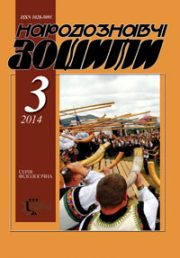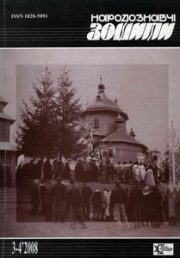The Ethnology Notebooks. 2022. № 5 (167), 1041—1058
UDK 930(477):[910.4:629.5.017.2](=161.2)(470+571)(092):[39+81](=56+=81/82)-047.37]”18″
DOI https://doi.org/10.15407/nz2022.05.1041
BILOUS Vira
- ORCID ID: https://orcid.org/0000-0001-7848-180X
- Candidate of Historical Sciences,
- Senior Researcher,
- The Institute of Ethnology of the NASU,
- The Department of Modern Ethnology,
- 15, Svobody Avenue, 79000, Lviv, Ukraine,
- Contacts: e-mail: bilka3@gmail.com
Abstract. Problem Statement. American studies achievements of Ukrainians belong to those pages of national historiography that are exceptionally sparingly represented in world humanitarianism. Vasyl Khromchenko (1792—1849) was one of the movers in this area. His heritage is actively used by foreign researchers of the traditional cultures and languages of the indi genous peoples of North America. However, the ethnic and social origin of V. Khromchenko remains unclear to this day. At most, Russian historiography interprets this figure, with a distinctly Ukrainian surname model, exclusively as a Russian scientist. That is why only under this marker he is known to the American and European scientific community.
The purpose of the article is to establish the ethnicity of V. Khromchenko, to reveal his contribution to the study of the genesis, ethnic history, traditional life, the languages of the Eskimos and Indians, and to consider his achievements in the context of the intellectual history of Ukrainians.
The biographical method and methods of genealogical research helped to establish the place of birth, and social origin of V. Khromchenko, to expand his scientific biography. The method of historiographical analysis made it possible to find out the scope, forms and features of his ethnographic collecting activities. The comparative-historical method made it possible to study the legacy of V. Khromchenko in comparison with the achievements of his predecessors and contemporaries, as well as with the latest developments.
The exploratory and analytical work resulted in finding evidence of the Ukrainian ethnicity of the seafarer. The Khromchenko family from the end of the 17th century, maps of his sea expeditions and ethnographic research along the western coast of North America have been reproduced. The priority of a native of Ukrainian ethnic lands in learning the culture and language of many Eskimo and Indian tribes of Alaska and California has been established. In conclusion, the factual importance of V. Khromchenko`s ethnographic and linguistic materials for global American studies and their active use in modern studies have been emphasised.
Keywords: Vasyl Khrochenko, seafarer, a native of Ukraine, genealogical research, ethnography, lexicographic material, Eskimos, Indians, Alaska, California.
Received 8.09.2022
REFERENCES
- Vanstone, J. (Ed.). (1973). V.S. Khromchenko’s Coastal Explorations in Southwestern Alaska, 1822. Fieldiana: Anthropology (Vol. 64, pp. 42—95).Chicago: Field Museum of Natural History.
- Pillng, J.K. (1887). Bibliography of the Eskimo Language. Wachington: Government Printing Office.
- Rudnyckyj, J.-B. (1982). Cape Khromchenko — a Ukrainian Toponym in Alaska. Onomastica, 61, 13—16.
- Burykin, A. (1957). Captain Khromchenko’s four voyages. Priroda, 3, 77—80 [in Russian].
- Dunmore, J. (1991). Who’s Who in Pacific Navigation. Honolulu; Hawaii: University of Hawaii Press.
- Petrov, A., & Bolhovitinov, N. (Ed.). (1999). The naval Officers Begin to Govern in the Russian`s North American Colonies, 1818—1825. In Bolhovitinov, N. History of Russian America (1732—1863): in 3 vol. Activities of the Russian-American company. International relationships (Vol. 2, pp. 339—395). Moscow: Mezhdunarodnyye otnosheniya [in Russian].
- Postnikov, A. (2000). Russian America in geographical descriptions and maps 1741—1867. Sankt-Peterburg: Dmitrij Bulanin [in Russian].
- Fedorova, S.(2011). Russian America: from the first settlements to the sale of Alaska. The end of the XVII—1867 year. Moscow: Lomonosov [in Russian].
- Khromchenko, V. (1824). Excerpts from the Journal of the Voyage of 1822. Severnyj Arhiv, 11, 254—274; 12, 303—314; 13—14, 38—64; 15, 119—131; 16, 177—186; 17, 235—248; 18, 297—318 [in Russian].
- Blomkvist, E., Ol’derogge, D., & Kinzhalov, R. (2 eds). (1975). The history of the study of North American Indian languages in Russia (from the MAE archive). Collection of the Museum of Anthropology and Ethnography. From the history of the cultural heritage of America and Africa (Vol. XXXI, pp. 96—117). Leningrad: Nauka; Leningradskoe otdelenie [in Russian].
- Kraus, M. (2017). Eyak Grammar. University of Alaska Fairbanks. Rasmuson Library. Alaska Native Language Archive. EY961K2009_2017draft.pdf. Retrieved from: https://www.uaf.edu/anla/record.php?identifier=EY961K2009 (Last accessed: 07.08.2022).
- Vanstone, J. (Ed.). (1973). Introduction. V.S. Khromchenko’s Coastal Explorations in Southwestern Alaska, 1822. Fieldiana: Anthropology. (Vol. 64, pp. 1—39). Chicago: Field Museum of Natural History.
- Norchenko, O. (2009). Captain Vasyl Khromchenko. Zapiski po gidrografii, 277, 83—88. Retrieved from: https://elib.rgo.ru/handle/123456789/224520 (Last accessed: 23.02.2022) [in Russian].
- Chukhlib, T. (2014). «Starodubshchyna» is waiting for a return…»: Historical, historiographical and political problems of the Ukrainian subregion of the Russian Federation. Siverian Chronicle, 5 (119), 230—255 [in Ukrainian].
- Confessional list of the Posudychi village of the Pogar protopope of the Novgorod-Siver Eparchy in 1793. State Archives of Chernihiv region (SACR). F. 679. Op. 1. Spr. 361. Ark. 87—106. Retrieved from: https://www.familysearch.org/ark:/61903/3:1:3Q9M-CSM4-L3C8-L?cat=1337569 (Last accessed: 1.08.2022) [in Russian].
- Confessional list of the Posudychi village of the Pogar protopope of the Novgorod-Siver Eparchy in 1796. SACR. F. 679. Op. 1. Spr. 526. Ark. 807—828. Retrieved from: https://www.familysearch.org/ark:/61903/3:1:3Q9M-CSMP-MQ66-H?i=1004&cat=1337569 (Last accessed:1.08.2022) [in Russian].
- Confessional list of the Posudychi village of the Pogar protopope of the Novgorod-Siver Eparchy in 1798. SACR. F. 712. Op. 1. Spr. 227. Ark. 88—105. Retrieved from: https://www.familysearch.org/ark:/61903/3:1:3Q9M-CSM4-L3C8-L?mode=g&cat=1337569 (Last accessed: 1.08.2022) [in Russian].
- Lists of students of the 1st and 2nd grades of the specialized school for the period from 1799 to 1825. Russian State Archive of the Navy (RSAN). F. 1212. Op. 1. Ed. sb. 309. List 6 [in Russian].
- Formulary record about the service and dignity of Vasyl Khromchenko the captain-lieutenant of the 4th fleet crew in 1842. RSAN. F. 406. Op. 3. Kn. 231. Delo 168. List 1102—1108 [in Russian].
- List of nobles of the Novgorod-Siver Governorate 1788. Manuscript Institute of the National Library of Ukraine named V.I. Vernadskyi. F. I. № 60497. Ark. 396 back—397 [in Russian].
- Census record of villages of Starodubsky district 1811. State archive of the Bryansk region. F. 134. Op. 1. Dela 40, 74, 148 [in Russian].
- Books of oaths of the Malorossiya regiments. 1731. Starodub regiment. Poharska Hundred. Russian State Archive of Ancient Acts. F. 248. Op. 103. Delo 8250. Retrieved from: http://forum.genoua.name/viewtopic.php?id=32 (Last accessed: 23.02.2022) [in Russian].
- Confessional list of the Posudychi village of the Pogar protopope of the Novgorod-Siver Eparchy in 1744. SACR. F. 679. Op. 1. Spr. 354. Ark. 98—115. Retrieved from: https://www.familysearch.org/ark:/61903/3:1:3Q9M-CSMP-93RG-1?mode=g&cat=1337569 (Last accessed: 1.08.2022) [in Russian].
- Confessional list of the Posudychi village of the Pogar protopope of the Novgorod-Siver Eparchy in 1781. SACR. F. 679. Op. 1. Spr. 360. Ark. 151—166. Retrieved from: https://www.familysearch.org/ark:/61903/3:1:3Q9M-CSMP-93DK-5?mode=g&cat=1337569 (Last accessed: 1.08.2022) [in Russian].
- Confessional list of the Posudychi village of the Pogar protopope of the Novgorod-Siver Eparchy in 1782. SACR. F. 679. Op. 1. Spr. 525. Ark. 205—227. Retrieved from: https://www.familysearch.org/ark:/61903/3:1:3Q9M-CSML-NSQW-3?mode=g&cat=1337569 (Last accessed: 1.08.2022) [in Russian].
- Modzalevskyi, V. (1908). Malorossiya`s genealogy: in 4 vol. (Vol. 1: A—D, pp. 238—270). Kyiv: Typ. T-va H.L. Frontskevycha i Ko [in Russian].
- Modzalevskyi, V. (1912). Malorossiya`s genealogy: in 4 vol. (Vol. 4: L—O, pp. 180—186). Kyiv: Typo-Litografia S.V. Kulzhenko [in Russian].
- Sytyi, I. (Ed.). (2008). Genealogy of the Ukrainian nobility: Service records of the Pogar nobility 1772—1781. «Description» of the Nizhyn nobility in 1784. Kyiv: Tempora [in Ukrainian].
- Shkvarov, A. (2016). When the Russians Came… Statistical study of the families of Russian military officials and Finnish women in the garrisons of Sveaborg and Helsingfors in the first half of the 19th century: based on the materials of the National Archives of Finland (Issue 1). Helsinki: RME Group Oy [in Russian].
- (1846). Address-calendar or general state of the Russian Empire: in 2 parts (Part 2). Sankt-Peterburg [in Russian].
- (1847). Address-calendar or general state of the Russian Empire: in 2 parts (Part 2). Sankt-Peterburg [in Russian].
- Pasetskyi, V. (1974). Ivan Fedorovych Kruzenshtern (1770—1849). Moskow: Nauka [in Russian].
- Berkh, V. (1823). Chronological history of all journeys to the northern polar countries: in 2 parts (Part 2). Sankt-Peterburg [in Russian].
- The Journal kept on the Golovnin`s brig in 1822 by Khramchenko, the midshipman of the fleet. State archive of the Perm region. F. 445. Op. 1. Delo 74. List 1—121 [in Russian].
- Khromchenko 1822 Jourrnal. University of Alaska Fairbanks. Rasmuson Library. Alaska Native Language Ar chive. IN822Kh1822a-01.pdf; IN822Kh1822a-04.pdf.Re trie ved from: https://www.uaf.edu/anla/record. php? iden ti fi er=IN822Kh1822a (Last accessed: 03.08.2022).
- Durov, A. (1959). Russian geographical names in the Pacific Ocean, on the territory of Alaska and the Aleutian Islands. Appendix. Geograpicheskij Sbornik (Issue 13, pp. 155—183). Moskow; Leningrad: Izd-vo Akad. Nauk SSSR [in Russian].
- Alekseev, A. (1982). Development of the Far East and Russian America by Russian people until the end of the 19th century. Moskow: Nauka [in Russian].
- Fedorova, S., & Lapunova, R. (Eds). (1979). Russian America in the unpublished notes of K. T. Khlebnikov. Leningrad: Nauka; Leningradskoe otdelenie [in Russian].
- A short dictionary of 9 dialects of the peoples living in the northwestern part of America, collected by Lieutenant Khramchenko. M. Saltykov-Shchedrin Russian National Library. Department of Manuscripts. F. 7. Op. 812. № 145. List 1—16 [in Russian].
- Alegmiut. Stuart Island and Nunivak. Yupik wordlists. University of Alaska Fairbanks. Rasmuson Library. Alaska Native Language Archive. CY822Khr1825.pdf. Retrieved from: https://www.uaf.edu/anla/record.php?identifier=CY822Khr1825 (Last accessed: 03.08.2022).
- Ahtna and Eyak wordlist. University of Alaska Fairbanks. Rasmuson Library. Alaska Native Language Archive. EY820K1820.pdf. Retrieved from: https://www.uaf.edu/anla/record.php?identifier=EY820K1820 (Last accessed: 03.08.2022).
- Lapunova, R., Dridzo, A., & Knizhalov, R. (2Eds.). (1994). Manuscript of K.T. Khlebnikov «Appendix … about the peoples inhabiting the colonies of the Russian American Company … ». Russian America: According to the personal impressions of missionaries, explorers, sailors, researchers and other eyewitnesses (Pp. 123—150). Moskow: Mysl’ [in Russian].
- Jaсobson, S. (Ed.). (2012). Yup’ik Eskimo Dictionary: in 2 vol. Ed. 2-rd.. Fairbanks: Alaska Native Language Center; University of Alaska.
- Vanstone, J. (1989). Nunivak Island Eskimo (Yupit) Technology and Material Culture. Fieldiana: Anthropology. New series, 12, 1—108.
- Kenneth, L. (2013). Deconstructing the Aglurmiut Migration: An Analysis if Accounts from the Russian America Period to the Present. Alaska Journal of Anthropology, 2—3 (Vol. 11, pp. 17—36). Retrieved from: https://www.alaskaanthropology.org/publications/open-access/volume-10-number-1-2-2012-2 (Last accessed: 03.08.2022).
- Fedorova, S. (Ed.). (1985). Russian America in Kirill Khlebnikov’s Notes. Moskow: Nauka [in Russian].
- Istomin, A., Aleksndrenkov, Je., & Istomin, A. (Eds.). (2012). P.S. Kostromitinov`s note «Brief remarks about the Ros Indians» — is the first systematic description of the Indians of Russian California (1834—1835). Sources from the ethnic history of the aboriginal population of America. Coll. of articles (Pp. 252—256). Moskow: IEA RAS [in Russian].







